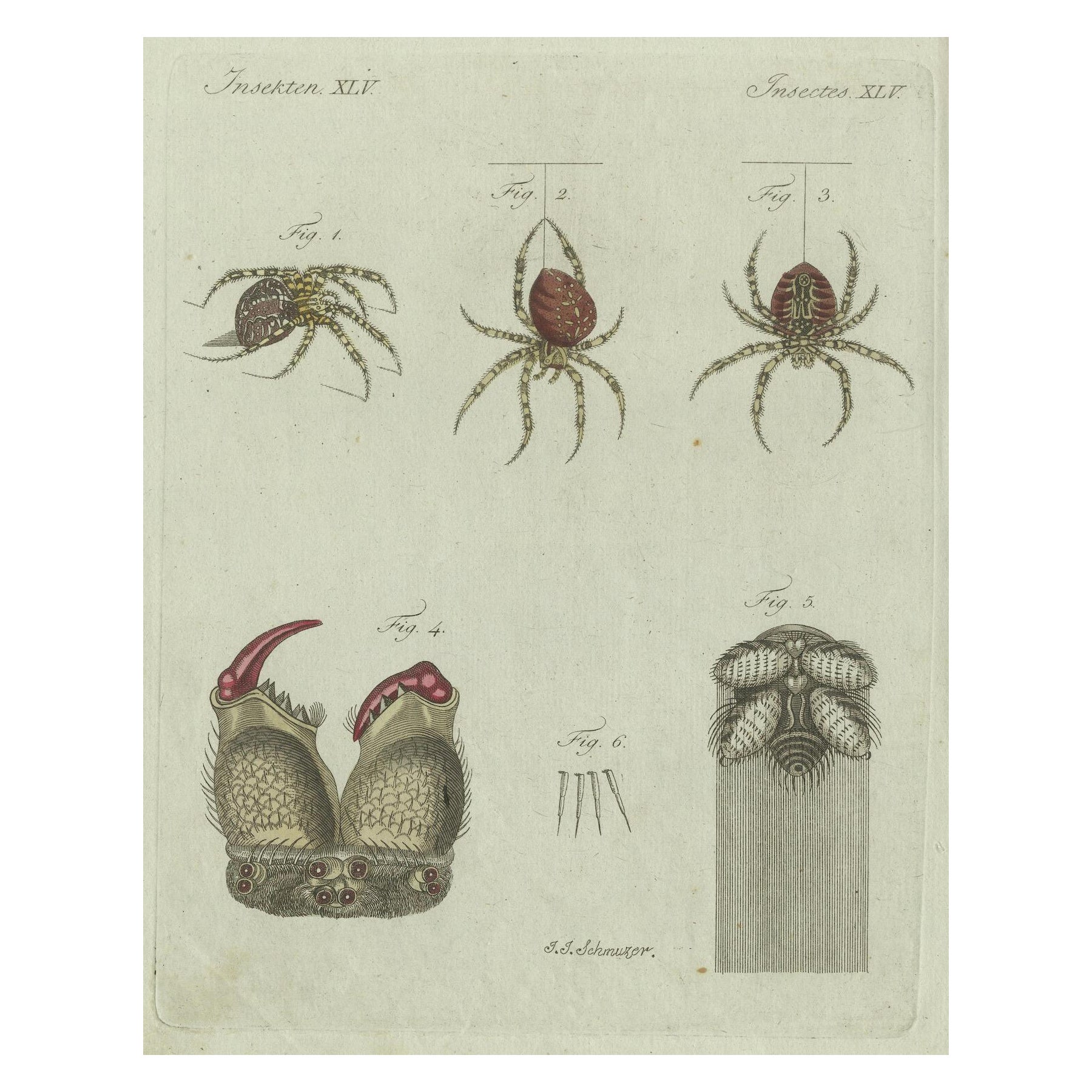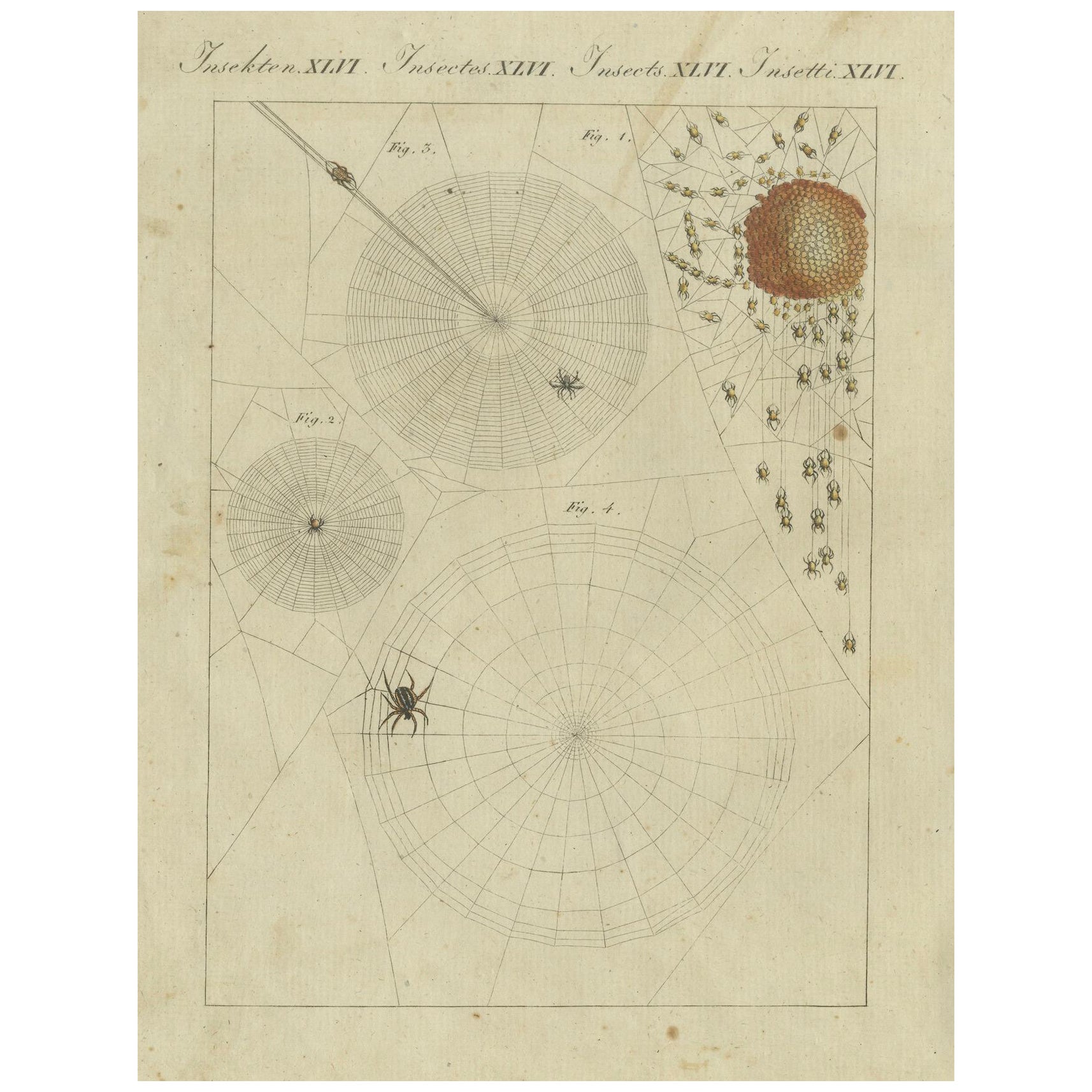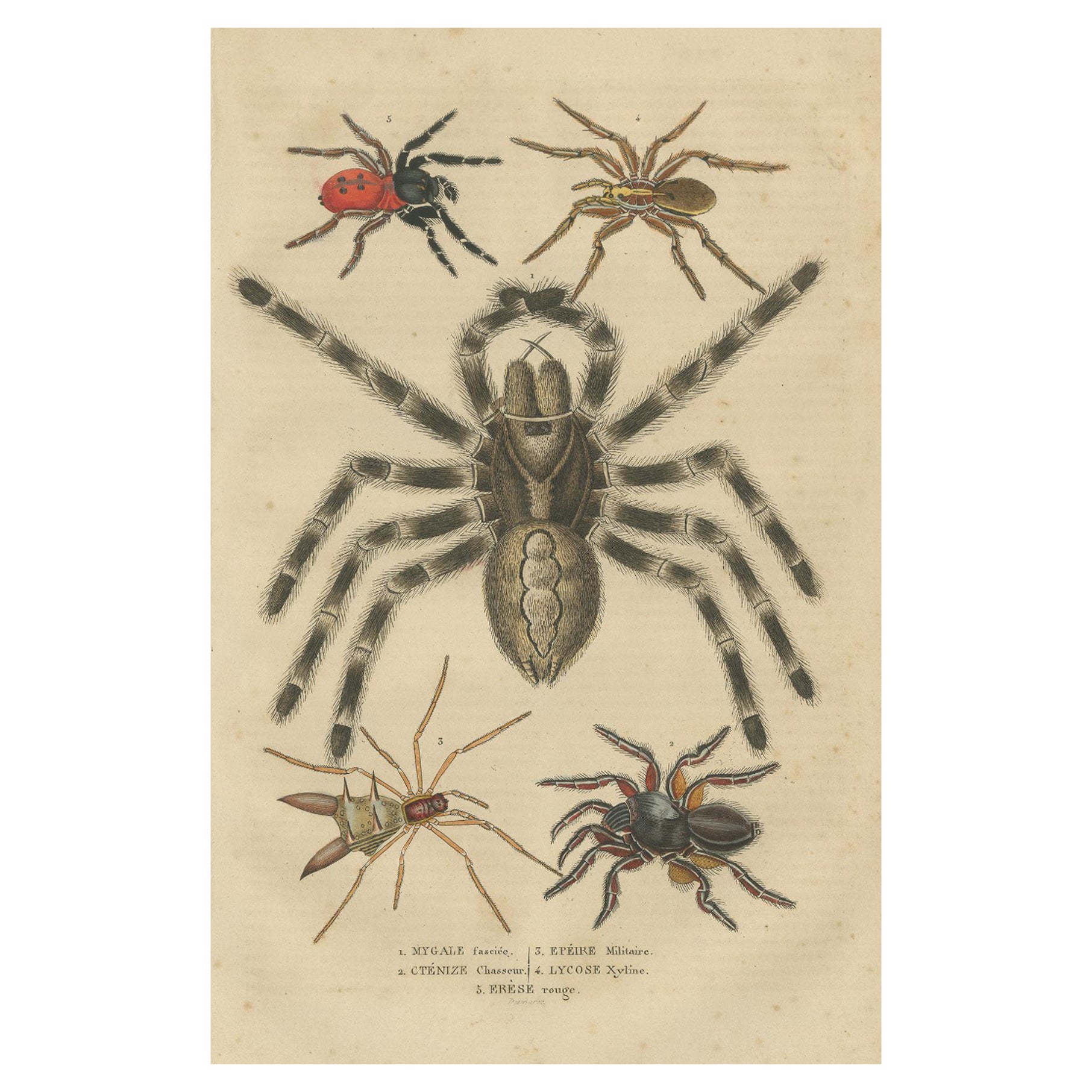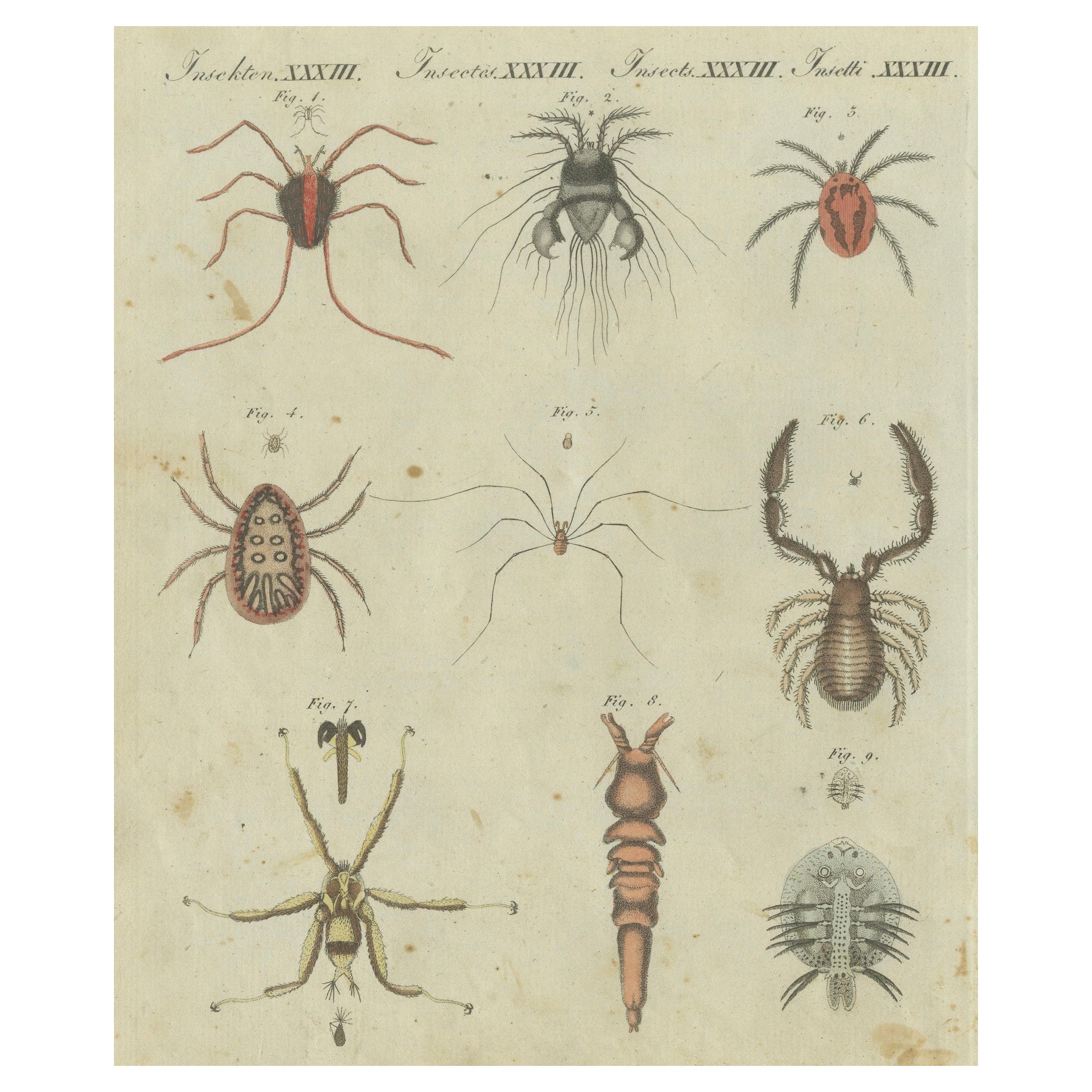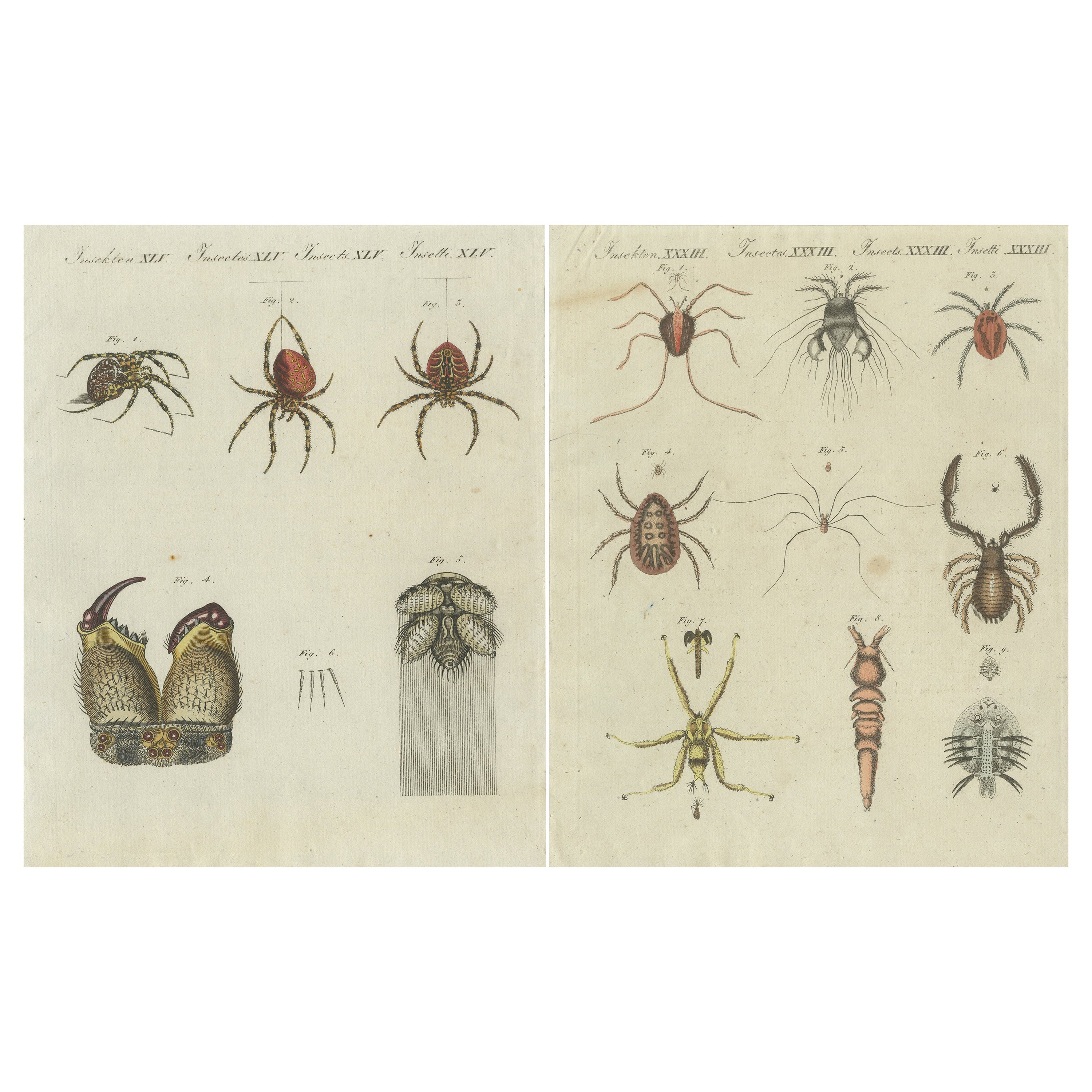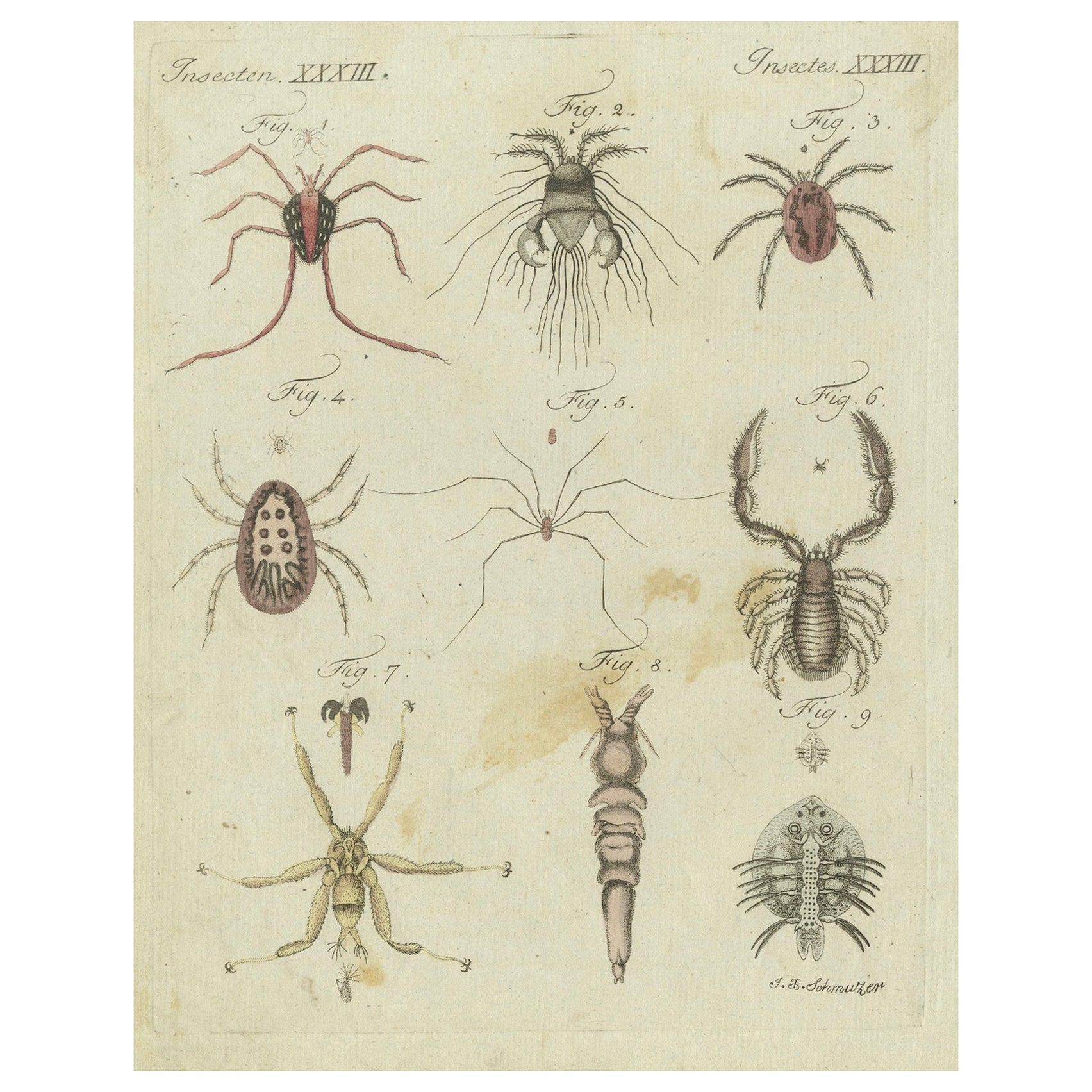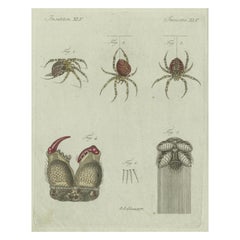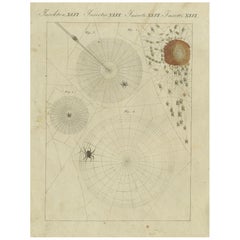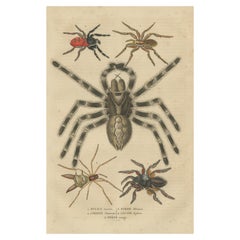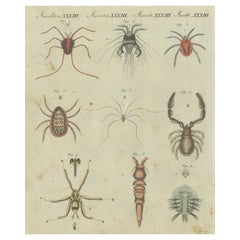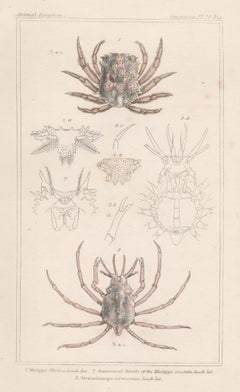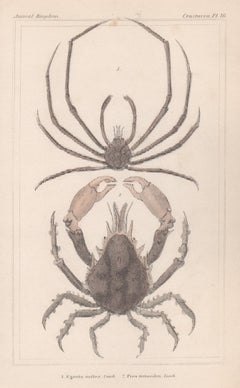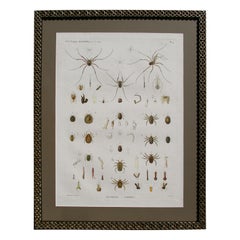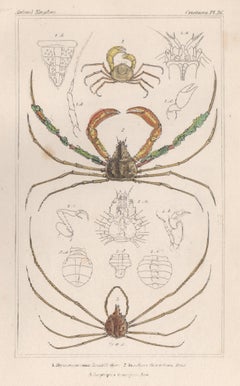Items Similar to European Garden Spider Anatomy: Variations, Silk Spinnerets, and Mandibles, 1805
Want more images or videos?
Request additional images or videos from the seller
1 of 7
European Garden Spider Anatomy: Variations, Silk Spinnerets, and Mandibles, 1805
$165.40
£123.98
€140
CA$227.24
A$253.69
CHF 132.93
MX$3,105.39
NOK 1,688.19
SEK 1,591.75
DKK 1,065.73
Shipping
Retrieving quote...The 1stDibs Promise:
Authenticity Guarantee,
Money-Back Guarantee,
24-Hour Cancellation
About the Item
"European Garden Spider Anatomy: Variations, Silk Spinnerets, and Mandibles"
This captivating hand-colored copperplate engraving, from Friedrich Johann Bertuch’s *Bilderbuch für Kinder* (Picture Book for Children), Weimar, 1805, offers a detailed study of the European garden spider, also known as the diadem spider (*Araneus diadematus*). The illustration explores anatomical features and behavioral traits, combining scientific accuracy with artistic beauty.
1. Figure 1: Depicts the black variety of the European garden spider, highlighting its characteristic round abdomen and intricate leg structure.
2. Figures 2-3: Illustrate the striking red variety of the spider, shown hanging from a silk line. The vibrant red markings and fine details emphasize the diversity within this species.
3. Figure 4: Provides a close-up view of the spider’s head, showcasing the mandibles and prominent eyes used for hunting and web construction.
4. Figure 5: Presents the silk spinnerets, revealing the intricate anatomy involved in spinning silk fibers. This fascinating aspect of spider biology is a testament to their evolutionary adaptability.
5. Figure 6: Displays detailed silk tubes, demonstrating how the spider produces and uses its web-building material.
This engraving exemplifies Bertuch’s dedication to educating young readers and adults alike, combining visual appeal with scientific observation. It is a remarkable piece of 19th-century natural history art.
### Condition Report
Very good condition with vibrant original hand coloring. Slight foxing and light toning on margins, consistent with age. Plate edges intact.
### Framing Tip
To highlight the intricate details, use a neutral mat and a simple, natural wood frame. UV-resistant glass will help preserve the engraving’s vibrant colors and delicate inkwork. This piece is perfect for an entomology-themed gallery or a scientific study display.
- Dimensions:Height: 9.06 in (23 cm)Width: 7.49 in (19 cm)Depth: 0.01 in (0.2 mm)
- Materials and Techniques:Paper,Engraved
- Period:
- Date of Manufacture:1805
- Condition:Good condition with vibrant original hand coloring. Slight foxing and light toning on margins, consistent with age. Plate edges intact.
- Seller Location:Langweer, NL
- Reference Number:Seller: BG-14000-891stDibs: LU3054343180582
About the Seller
5.0
Recognized Seller
These prestigious sellers are industry leaders and represent the highest echelon for item quality and design.
Platinum Seller
Premium sellers with a 4.7+ rating and 24-hour response times
Established in 2009
1stDibs seller since 2017
2,511 sales on 1stDibs
Typical response time: <1 hour
- ShippingRetrieving quote...Shipping from: Langweer, Netherlands
- Return Policy
Authenticity Guarantee
In the unlikely event there’s an issue with an item’s authenticity, contact us within 1 year for a full refund. DetailsMoney-Back Guarantee
If your item is not as described, is damaged in transit, or does not arrive, contact us within 7 days for a full refund. Details24-Hour Cancellation
You have a 24-hour grace period in which to reconsider your purchase, with no questions asked.Vetted Professional Sellers
Our world-class sellers must adhere to strict standards for service and quality, maintaining the integrity of our listings.Price-Match Guarantee
If you find that a seller listed the same item for a lower price elsewhere, we’ll match it.Trusted Global Delivery
Our best-in-class carrier network provides specialized shipping options worldwide, including custom delivery.More From This Seller
View AllEuropean Garden Spider Anatomy: Hand-Colored Engraving from Bertuch, 1798
Located in Langweer, NL
Title: European Garden Spider Anatomy: Hand-Colored Engraving from Bertuch's "Bilderbuch für Kinder" (1798)
Description: This detailed hand-colored copperplate engraving from Frie...
Category
Antique 1790s Prints
Materials
Paper
Web Designs of the European Garden Spider (Araneus diadematus), Engraved in 1805
Located in Langweer, NL
Title : "Web Designs of the European Garden Spider (Araneus diadematus)"
Description :
This fascinating hand-colored copperplate engraving from Friedrich Johann Bertuch’s *Bilder...
Category
Antique Early 1800s Prints
Materials
Paper
Antique 1845 Arachnid Study: Handcolored Engraving of Varied Spider Species
Located in Langweer, NL
This exquisite 1845 handcolored engraving is a testament to the scientific curiosity and artistic detail of the 19th century. The print features a collection of five arachnids, each ...
Category
Antique 1840s Prints
Materials
Paper
$274 Sale Price
20% Off
Free Shipping
Intricate Arachnids and Insects: Hand-Colored Engraving Published in 1805
Located in Langweer, NL
Title: Engraving of Arachnids and Insects from Early 19th-Century Natural History Collection
Description:
This detailed engraving, part of an early 19th-century natural history co...
Category
Antique Early 1800s Prints
Materials
Paper
$93 Sale Price
20% Off
Set of Two Antique Prints of Various Insects Including Spiders and Mites
Located in Langweer, NL
Set of two original antique prints of various insects including spiders, mites and others. These prints originate from 'Bilderbuch fur Kinder' by F.J. Bertuch. Friedrich Johann Bertu...
Category
Antique Early 19th Century Prints
Materials
Paper
$274 Sale Price / set
20% Off
Mites and Spiders: Hand-Colored Engraving from Bertuch's Bilderbuch für Kinder
Located in Langweer, NL
Title: Mites and Spiders: Hand-Colored Engraving from Bertuch's "Bilderbuch für Kinder" (1790s)
Description: This hand-colored copperplate engraving illustrates various mites and ...
Category
Antique 1790s Prints
Materials
Paper
You May Also Like
Crustaceans - crabs, antique English natural history engraving print, 1837
Located in Melbourne, Victoria
'Crustacea'
Copper-line engraving with original hand-colouring. From Baron Georges Cuvier's (1769-1832) 'Animal Kingdom', published in London in 1837.
210mm by 130mm (sheet)
Category
Mid-19th Century Naturalistic Animal Prints
Materials
Engraving
Crustaceans - crabs, antique English natural history engraving print, 1837
Located in Melbourne, Victoria
'Crustacea'
Copper-line engraving with original hand-colouring. From Baron Georges Cuvier's (1769-1832) 'Animal Kingdom', published in London in 1837.
210mm by 130mm (sheet)
Category
Mid-19th Century Naturalistic Animal Prints
Materials
Engraving
19 th Century Framed Zoological Print of Arachnides from Egypt
By Marie Jules César Lelorgne De Savigny
Located in Los Angeles, CA
Rare original Print by Marie Jules César Lelorgne de Savigny (5 April 1777 – 5 Octobre 1851)The French zoologist who accompanied Napoleon Bonapart on his Egy...
Category
Antique 19th Century French Prints
Crustaceans - crabs, antique English natural history engraving print, 1837
Located in Melbourne, Victoria
'Crustacea'
Copper-line engraving with original hand-colouring. From Baron Georges Cuvier's (1769-1832) 'Animal Kingdom', published in London in 1837.
210mm by 130mm (sheet)
Category
Mid-19th Century Naturalistic Animal Prints
Materials
Engraving
Crustaceans - crabs, antique English natural history engraving print, 1837
Located in Melbourne, Victoria
'Crustacea'
Copper-line engraving with original hand-colouring. From Baron Georges Cuvier's (1769-1832) 'Animal Kingdom', published in London in 1837.
210mm by 130mm (sheet)
Category
Mid-19th Century Naturalistic Animal Prints
Materials
Engraving
Victorian "Bird" Spider Print
Located in Riverdale, NY
Victorian "Bird" Spider print mounted on a lovely faux marble paper ground showing large spider attacking a trapped bird. Black painted wood frame. Some p...
Category
Antique 1890s European Late Victorian Prints
Materials
Wood, Paper
More Ways To Browse
French 18th Century Wood Angel
French Wine Jars
Fruit Bowl Clay
Fusee Enamel
George Iii Bracket Clock
Goldscheider Figures
Guanyin Carved Wood
Herend Apponyi Green
Herend Chinese Bouquet Green
Hutschenreuther Selb
Imperial Porphyry
Italian Twin Beds
Neutra Richard
Oval Shaped Sofa
Paddle Board
Painted 18th Century Grandfather Clocks
Painted Curio Cabinet
Pair Bow Front Chests
